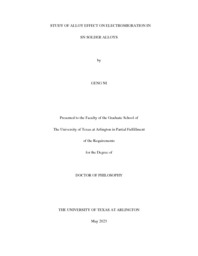| dc.description.abstract | This dissertation presents experimental results about the alloy effect on the Electromigration (EM) of Sn in Sn-based binary and ternary alloys. By using cross-stripe configuration, the alloy effect on EM of Sn can be characterized from marker polarity, and the migration of alloy element under EM can be measured from marker front motion. In the dissertation, the mechanism of alloy effect on EM of Sn, “Two-Phase equilibrium”, will be introduced.
Electromigration is a phenomenon where metallic atoms are migrated at the direction of electron flow under high current density. In response to the demands for greater speed and smaller size, semiconductor devices must now be designed to carry higher current densities than ever before. Which makes electromigration failure become a concern, especially in Sn-based solder interconnects due to its significant application in integrated circuits. Alloying may be the most effective method to slow down the EM of Sn, and fundamental studies on EM of Sn are not very well understood yet. Driven by these two motivations, this project is intended to study the alloy effect on electromigration fo Sn, and Cross-stripe configuration is selected as experimental configuration in the project to study alloy effect. “Cross-stripe” was originally developed for studying Al alloying effect on electromigration of Cu. Due to the different EM rate of Sn between cross-stripe (alloyed) and stripe (metrix) areas, markers (hillock and void) induced by Kirkendall effect will initially form at boundaries of alloyed areas, and keep developing during testing. Polarity of marker formation, and motion of markers fronts thus become important parameters for characterization of alloying effect on EM rate change of Sn. Our study was initally aimed at better chatacterization about EM kinetics of alloy elements (such as Cu, Ni, Ag and Au etc.) in Sn solder interconnects, but moved further into the study about their suppression abilities on the EM rate of Sn.
Based on the expermental result achieved with various elements, all tested elements can suppress EM rate of Sn when their concentrations beyond maximum solubility limit and form inter-matellic compound (IMC) as percipiates. When alloy element concentrations are below maximum solubility, which means they exist as solute in Sn metrix, some elements like (N iand Bi) remain EM suppression of Sn, however most of elements like (Au, Ag, Cu, Pd and Co) may accelerate the EM rate of Sn. The two-phases equilibrium between Sn and Sn-based IMC is the key mechanism affecting the EM rate of Sn, not the presence of alloying elements themselves. This finding suggests that the EM reliability of Sn can be improved by either adding EM suppression elements, or producing Sn grain structure with IMC (two-phases equilibrium) by adding enough amount of alloy element beyond maximum solubility.
In the study of ternary samples, we explore the interactions between different alloying elements by applying a cross-stripe of secondary alloying elements onto an alloyed Sn stripe. Based on the result, existence of Ag will make Cu migrates faster in existing Cu-Sn system. Which is an implication to SAC alloys. Also, co-existence of Ni and Cu may further suppress the EM of Sn. Therefore, IMC stability can be increased and leads to the improvement of EM reliability of Sn in ternary systems.
The results reported in this dissertation provide a comprehensive and plausible explanation of the alloy effect on electromigration of Sn, and offer insights for improving the reliability of Sn solder interconnects against EM. | |


